Publications
ADS links: all refereed only Google Scholar: profile
| Magnetic field amplification in massive primordial halos: Influence of Lyman-Werner radiation | |
|---|---|
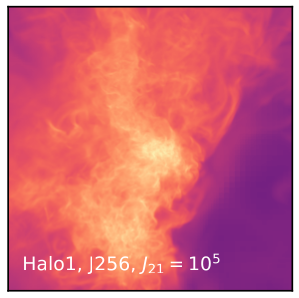 |
The potential importance of magnetic fields during structure formation and gravitational collapse in the early Universe has been shown in several studies. In particular, magnetic field amplification by the small-scale dynamo plays an important role in addition to the pure amplification expected from gravitational collapse. In this paper, we study the small-scale dynamo for halos of ≳107 M⊙ collapsing at z≳12, under different ambient conditions due to the strength of the Lyman-Werner background. Additionally, we estimate the approximate saturation level by varying the initial magnetic field strength. We performed cosmological magnetohydrodynamical simulations for three distinct halos of ∼107 M⊙ at z≥13 by varying the Jeans resolution from 32−256 cells and employed Lyman Werner background flux of strengths 102−105 in units of J21, where J21=10-21 erg/cm2/sr/s/Hz. To follow the chemical and thermal evolution of the gas we made use of the KROME package. In addition to the compression by collapse, we find magnetic field amplification via the dynamo both in the regimes of atomic and molecular hydrogen cooling. Moreover, we find a lower saturation level in the molecular hydrogen cooling regime. This behaviour can be understood due to the generally reduced radial infall velocities and vorticities in this regime, as well as the higher Mach numbers of the gas, which give rise to a smaller saturation ratio. Our results overall suggest that the dynamo operates over a large range of conditions in the collapsing gas. |
| V.B. Díaz, D.R.G. Schleicher, M.A. Latif, P. Grete, R. Banerjee | |
| in press Astronomy & Astrophysics doi:10.1051/0004-6361/202347783 arXiv:2401.04054 |
| Frontier: Exploring Exascale | |
|---|---|
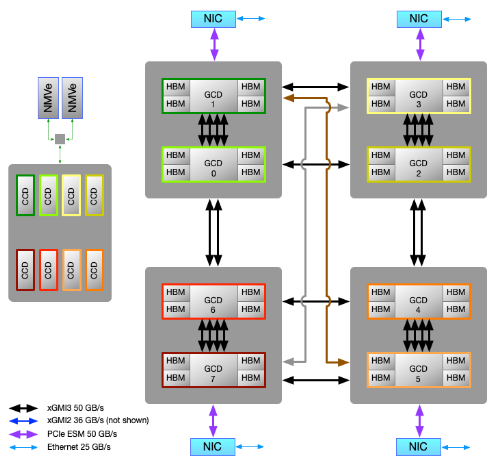 |
As the US Department of Energy (DOE) computing facilities began deploying petascale systems in 2008, DOE was already setting its sights on exascale. In that year, DARPA published a report on the feasibility of reaching exascale. The report authors identified several key challenges in the pursuit of exascale including power, memory, concurrency, and resiliency. That report informed the DOE's computing strategy for reaching exascale. With the deployment of Oak Ridge National Laboratory's Frontier supercomputer, we have officially entered the exascale era. In this paper, we discuss Frontier's architecture, how it addresses those challenges, and describe some early application results from Oak Ridge Leadership Computing Facility's Center of Excellence and the Exascale Computing Project. |
| S. Atchley, C. Zimmer, J. Lange, D. Bernholdt, V. Melesse Vergara, T. Beck, M. Brim, R. Budiardja, S. Chandrasekaran, M. Eisenbach, T. Evans, M. Ezell, N. Frontiere, A. Georgiadou, J. Glenski, P. Grete, S. Hamilton, J. Holmen, A. Huebl, D. Jacobson, W. Joubert, K. McMahon, E . Merzari, S. Moore, A. Myers, S. Nichols, S. Oral, T. Papatheodore, D. Perez, D. Rogers, E. Schneider, J. Vay, and P. Yeung | |
| 2023 SC '23: Proceedings of the International Conference for High Performance Computing, Networking, Storage and Analysis 52 1-16 doi:10.1145/3581784.3607089 Open Access | |
| Nominated for Best Paper Award |
| As a matter of dynamical range — scale dependent energy dynamics in MHD turbulence | |
|---|---|
 |
Magnetized turbulence is ubiquitous in many astrophysical and terrestrial plasmas but no universal theory exists. Even the detailed energy dynamics in magnetohydrodynamic (MHD) turbulence are still not well understood. We present a suite of subsonic, super-Alfvénic, high plasma-beta MHD turbulence simulations that only vary in their dynamical range, i.e., in their separation between the large-scale forcing and dissipation scales, and their dissipation mechanism (implicit large eddy simulation, ILES, versus and direct numerical simulation, DNS). Using an energy transfer analysis framework we calculate the effective, numerical viscosities and resistivities and demonstrate and that all ILES calculations of MHD turbulence are resolved and correspond to an equivalent visco-resistive MHD turbulence calculation. Increasing the number of grid points used in an ILES corresponds to lowering the dissipation coefficients, i.e., larger (kinetic and magnetic) Reynolds numbers for a constant forcing scale. Independently, we use this same framework to demonstrate that — contrary to hydrodynamic turbulence — the cross-scale energy fluxes are not constant in MHD turbulence. This applies both to different mediators (such as cascade processes or magnetic tension) for a given dynamical range as well as to a dependence on the dynamical range itself, which determines the physical properties of the flow. We do not observe any indication of convergence even at the highest resolution (largest Reynolds numbers) simulation at 2,0483 cells, calling into question whether an asymptotic regime in MHD turbulence exists, and, if so, what it looks like. |
| P. Grete, B. W. O'Shea, and K. Beckwith | |
| 2023 The Astrophysical Journal Letters 942 L34 doi:10.3847/2041-8213/acaea7 arXiv:2211.09750 |
| Early Experiences on the OLCF Frontier System with AthenaPK and Parthenon-Hydro | |
|---|---|
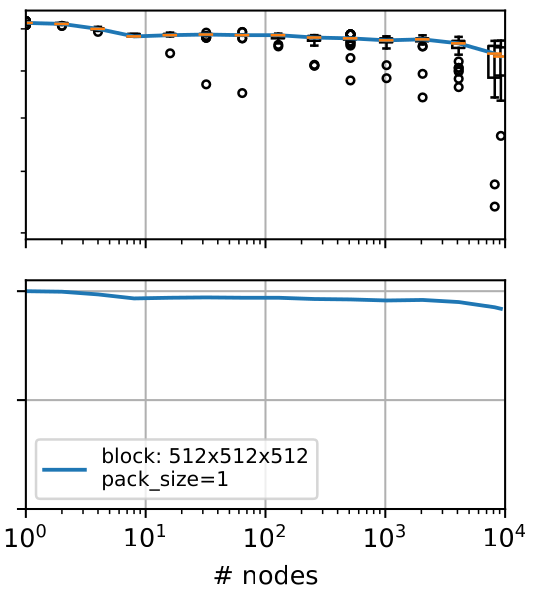 |
The Oak Ridge Leadership Computing Facility (OLCF) has been preparing the nation’s first exascale system, Frontier, for production and end users. Frontier is based on HPE Cray’s new EX architecture and Slingshot interconnect and features 74 cabinets of optimized 3rd Gen AMD EPYC CPUs for HPC and AI and AMD Instinct 250X accelerators. As a part of this preparation, “real-world” user codes have been selected to help assess the functionality, performance, and usability of the system. This paper describes early experiences using the system in collaboration with the Hamburg Observatory for two selected codes, which have since been adopted in the OLCF Test Harness. Experiences discussed include efforts to resolve performance variability and per-cycle slowdowns. Results are shown for a performance portable astrophysical magnetohydronamics code, AthenaPK, and a mini-application stressing the core functionality of a performance portable block-structured adaptive mesh refinement (AMR) framework, Parthenon-Hydro. These results show good scaling characteristics to the full system. At the largest scale, the Parthenon-Hydro miniapp reaches a total of 1.7x1013 zone-cycles/s on 9,216 nodes (73,728 logical GPUs) at ~92% weak scaling parallel efficiency (starting from a single node using a second-order, finite-volume method). |
| J. K. Holmen, P. Grete, and V. G. Melesse Vergara | |
| in press Concurrency and Computation Practice and Experience Journal Special Issue doi:10.1002/cpe.8069 Open Access |
| The Launching of Cold Clouds by Galaxy Outflows. V. The Role of Anisotropic Thermal Conduction | |
|---|---|
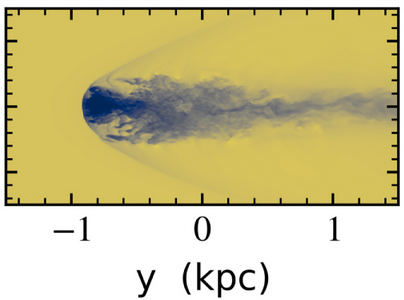 |
Motivated by observations of multiphase galaxy outflows, we explore the impact of isotropic and anisotropic electron thermal conduction on the evolution of radiatively cooled, cold clouds embedded in hot, magnetized winds. Using the adaptive-mesh refinement code AthenaPK, we conduct simulations of clouds impacted by supersonic and transonic flows with magnetic fields initially aligned parallel and perpendicular to the flow direction. In cases with isotropic thermal conduction, an evaporative wind forms, stabilizing against instabilities and leading to a mass-loss rate that matches the hydrodynamic case. In anisotropic cases, the impact of conduction is more limited and strongly dependent on the field orientation. In runs with initially perpendicular fields, the field lines are folded back into the tail, strongly limiting conduction, but magnetic fields act to dampen instabilities and slow the stretching of the cloud in the flow direction. In the parallel case, anisotropic conduction aids cloud survival by forming a radiative wind near the front of the cloud, which suppresses instabilities and reduces mass loss. In all cases, anisotropic conduction has a minimal impact on the acceleration of the cloud. |
| M. Brüggen, E. Scannapieco, and P. Grete | |
| 2023 The Astrophysical Journal 951 113 doi:10.3847/1538-4357/acd63e arXiv:2304.09881 |
| A morphological analysis of the substructures in radio relics | |
|---|---|
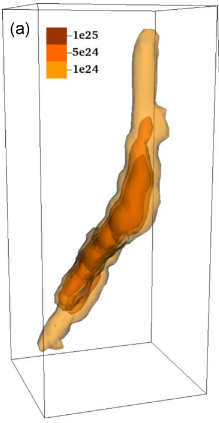 |
Recent observations of radio relics – diffuse radio emission in galaxy clusters – have revealed that these sources are not smooth but consist of structures in the form of threads and filaments. We investigate the origin of these filamentary structures and the role of projection effects. To this end, we have developed a tool that extracts the filamentary structures from background emission. Moreover, it is capable of studying both two-dimensional and three-dimensional objects. We apply our structure extractor to both observations and cosmological simulations of radio relics. Using Minkowski functionals, we determine the shape of the identified structures. In our 2D analysis, we find that the brightest structures in the observed and simulated maps are filaments. Our analysis of the 3D simulation data shows that radio relics do not consist of sheets but only of filaments and ribbons. Furthermore, we did not find any measurable projection effect that could hide any sheet-like structures in projection. We find that both the magnetic field and the shock front consist of filaments and ribbons that cause filamentary radio emission. |
| D. Wittor, M. Brüggen, P. Grete, and K. Rajpurohit | |
| 2023 Monthly Notices of the Royal Astronomical Society 523 1 701-719 doi:10.1093/mnras/stad1463 arXiv:2305.07046 |
| Parthenon — a performance portable block-structured adaptive mesh refinement framework | |
|---|---|
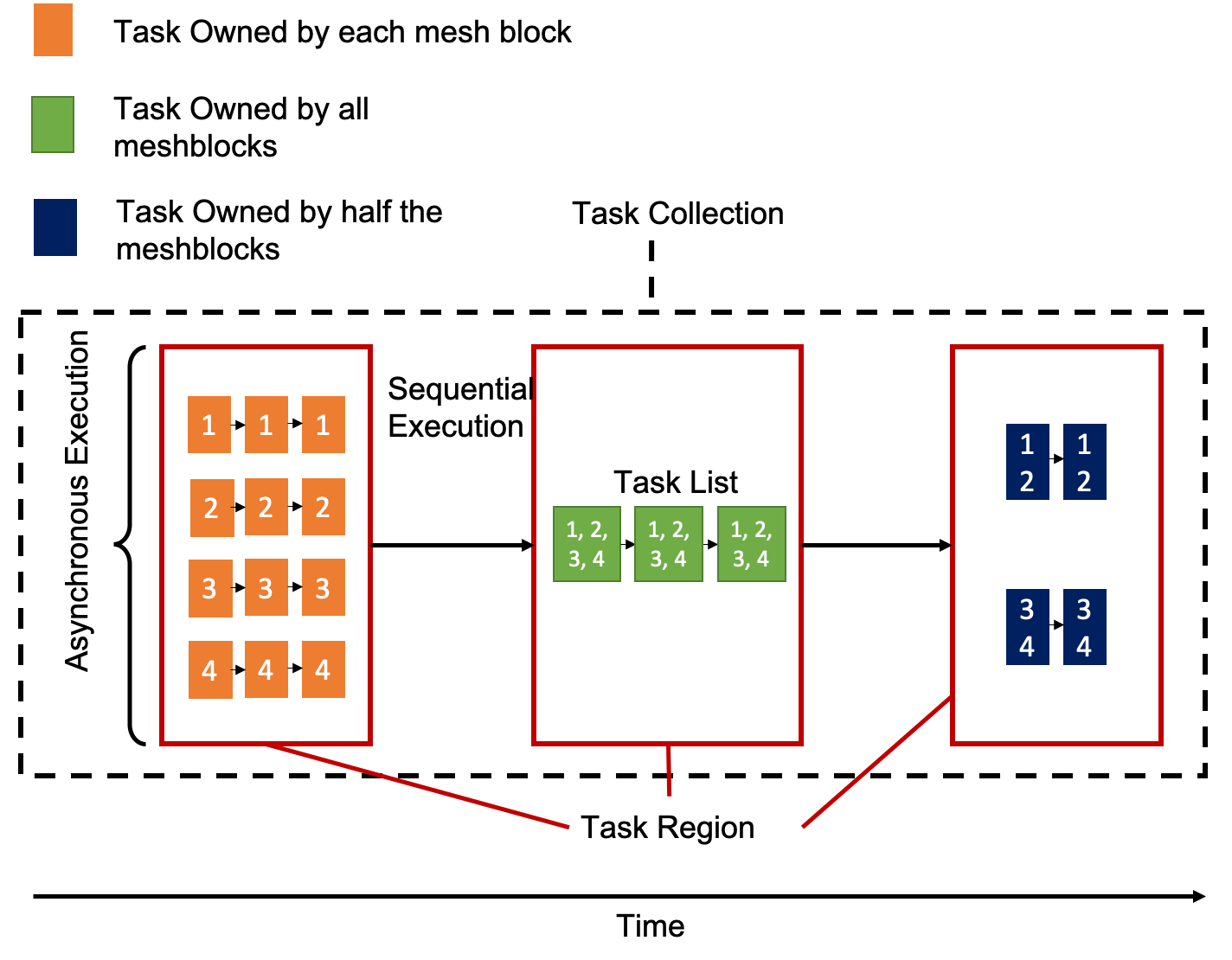 |
On the path to exascale the landscape of computer device architectures and corresponding programming models has become much more diverse. While various low-level performance portable programming models are available, support at the application level lacks behind. To address this issue, we present the performance portable block-structured adaptive mesh refinement (AMR) framework Parthenon, derived from the well-tested and widely used Athena++ astrophysical magnetohydrodynamics code, but generalized to serve as the foundation for a variety of downstream multi-physics codes. Parthenon adopts the Kokkos programming model, and provides various levels of abstractions from multi-dimensional variables, to packages defining and separating components, to launching of parallel compute kernels. Parthenon allocates all data in device memory to reduce data movement, supports the logical packing of variables and mesh blocks to reduce kernel launch overhead, and employs one-sided, asynchronous MPI calls to reduce communication overhead in multi-node simulations. Using a hydrodynamics miniapp, we demonstrate weak and strong scaling on various architectures including AMD and NVIDIA GPUs, Intel and AMD x86 CPUs, as well as Fujitsu A64FX CPUs. At the largest scale, the miniapp reaches a total of 3.5x1012 zone-cycles/s on 4096 Summit nodes (24576 GPUs) at ~55% weak scaling parallel efficiency (starting from a single node). In combination with being an open, collaborative project, this makes Parthenon an ideal framework to target exascale simulations in which the downstream developers can focus on their specific application rather than on the complexity of handling massively-parallel, device-accelerated AMR. |
| P. Grete, J. C. Dolence, J. M. Miller, J. Brown, B. Ryan, A. Gaspar, F. W. Glines, S. Swaminarayan, J. Lippuner, C. J. Solomon, G. Shipman, C. Junghans, D. Holladay, J. M. Stone, Luke F. Roberts | |
| 2023 The International Journal of High Performance Computing Applications 37 5 doi:10.1177/10943420221143775 and arXiv:2202.12309 |
| An Inquiry Approach to Teaching Sustainable Software Development with Collaborative Version Control | |
|---|---|
 |
Software development is becoming increasingly ubiquitous in STEM disciplines resulting in the need for education in associated computational skills. To address this need, we designed a "Sustainable Software Development with Collaborative Version Control" workshop in the 2019 Institute for Scientist & Engineer Educators (ISEE) Professional Development Program (PDP). We describe here the development process and following delivery of the workshop. In particular, we explored how to apply an inquiry approach to learning computational skills. By design, PDP activities intertwine content and “cognitive STEM practices,” and teasing apart content and practice is important for STEM education. We encountered challenges with this task because our content — exploring software sustainability with collaborative version control — is much like a practice in itself. We designed our workshop to introduce the critical skill of sustainable software development using collaborative version control systems with an inquiry approach rather than the more typically used, strictly technical approach. We emphasize the authentic, broadly applicable nature of the workshop in which learners jointly design, test, and discuss their own increasingly complex development workflows. The development process for our workshop may be useful for educators who want to introduce software practices to learners from many disparate STEM disciplines that leverage computational methods and require software development to approach research questions. |
| R. L. Frisbie, P. Grete, and F. W. Glines | |
| 2022 in UC Santa Cruz: Leaders in effective and inclusive STEM: Twenty years of the Institute for Scientist & Engineer Educators pp. 249-260 https://escholarship.org/uc/item/6fv1s464 |
| Turbulence in the intragroup and circumgalactic medium | |
|---|---|
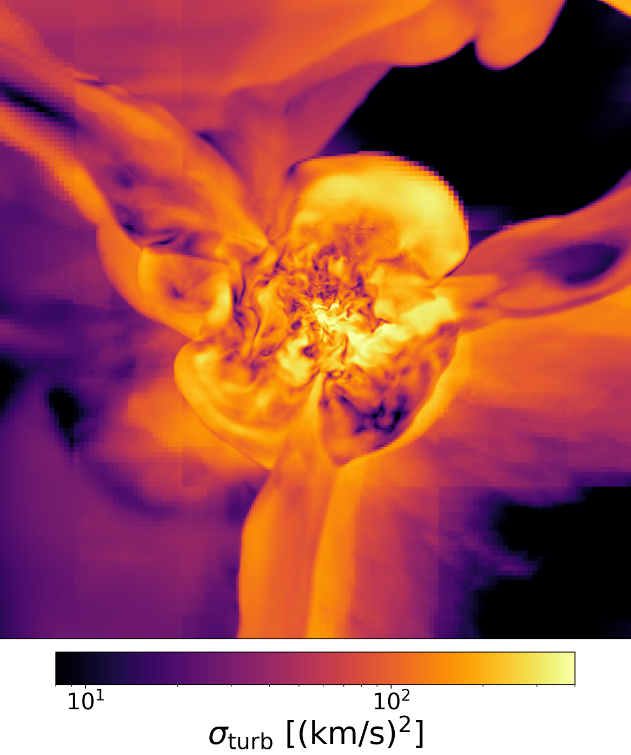 |
Context. In massive objects, such as galaxy clusters, the turbulent velocity dispersion, σturb, is tightly correlated to both the object mass, M, and the thermal energy. Aims. Here, we investigate whether these scaling laws extend to lower-mass objects in dark-matter filaments. Methods. We perform a cosmological zoom-in simulation of a filament using an adaptive filtering technique for the resolved velocity component and a subgrid-scale model to account for the unresolved component. We then compute the mean turbulent and thermal energies for all halos in the zoom-in region and compare different definitions of halo averages. Averaging constrained by density and temperature thresholds is favored over averages solely based on virial spheres. Results. We find no clear trend for the turbulent velocity dispersion versus halo mass, but significant correlation and a scaling law with exponent α ∼ 0.5 between the turbulent velocity dispersion and thermal energy that agrees with a nearly constant turbulent Mach number, similar to more massive objects. Conclusions. We conclude that the self-similar energetics proposed for galaxy clusters extends down to the circumgalactic medium of individual galaxies. |
| W. Schmidt, J. P. Schmidt, and P. Grete | |
| 2021 Astronomy & Astrophysics A115 12 doi:10.1051/0004-6361/202140920 arXiv:2107.12125 |
| As a Matter of Tension: Kinetic Energy Spectra in MHD Turbulence | |
|---|---|
 |
Magnetized turbulence is ubiquitous in many astrophysical and terrestrial systems but no complete, uncontested theory even in the simplest form, magnetohydrodynamics (MHD), exists. Many theories and phenomenologies focus on the joint (kinetic and magnetic) energy fluxes and spectra. We highlight the importance of treating kinetic and magnetic energies separately to shed light on MHD turbulence dynamics. We conduct an implicit large eddy simulation of subsonic, super-Alfvénic MHD turbulence and analyze the scale-wise energy transfer over time. Our key finding is that the kinetic energy spectrum develops a scaling of approximately k-4/3 in the stationary regime as the kinetic energy cascade is suppressed by magnetic tension. This motivates a reevaluation of existing MHD turbulence theories with respect to a more differentiated modeling of the energy fluxes. |
| P. Grete, B. W. O'Shea, and K. Beckwith | |
| 2021 The Astrophysical Journal 909 148 doi:10.3847/1538-4357/abdd22 arXiv:2009.03342 |
| Magnetized decaying turbulence in the weakly compressible Taylor-Green vortex | |
|---|---|
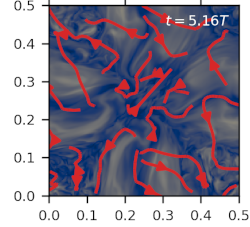 |
Magnetohydrodynamic (MHD) turbulence affects both terrestrial and astrophysical plasmas. The properties of magnetized turbulence must be better understood to more accurately characterize these systems. This work presents ideal MHD simulations of the compressible Taylor-Green vortex under a range of initial subsonic Mach numbers and magnetic field strengths. We find that regardless of the initial field strength, the magnetic energy becomes dominant over the kinetic energy on all scales after at most several dynamical times. The spectral indices of the kinetic and magnetic energy spectra become shallower than k-5/3 over time and generally fluctuate. Using a shell-to-shell energy transfer analysis framework, we find that the magnetic fields facilitate a significant amount of the energy flux and that the kinetic energy cascade is suppressed. Moreover, we observe nonlocal energy transfer from the large-scale kinetic energy to intermediate and small-scale magnetic energy via magnetic tension. We conclude that even in intermittently or singularly driven weakly magnetized systems, the dynamical effects of magnetic fields cannot be neglected. |
| F. W. Glines, P. Grete, and B. W. O'Shea | |
| 2021 Phys. Rev. E 103, 043203 doi:10.1103/PhysRevE.103.043203 arXiv:2009.01331 |
| K-Athena: a performance portable structured grid finite volume magnetohydrodynamics code | |
|---|---|
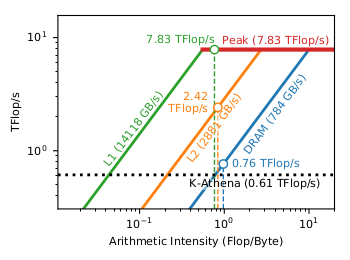 |
Large scale simulations are a key pillar of modern research and require ever-increasing computational resources. Different novel manycore architectures have emerged in recent years on the way towards the exascale era. Performance portability is required to prevent repeated non-trivial refactoring of a code for different architectures. We combine Athena++, an existing magnetohydrodynamics (MHD) CPU code, with Kokkos, a performance portable on-node parallel programming paradigm, into K-Athena to allow efficient simulations on multiple architectures using a single codebase. We present profiling and scaling results for different platforms including Intel Skylake CPUs, Intel Xeon Phis, and NVIDIA GPUs. K-Athena achieves >108 cell-updates/s on a single V100 GPU for second-order double precision MHD calculations, and a speedup of 30 on up to 24,576 GPUs on Summit (compared to 172,032 CPU cores), reaching 1.94×1012 total cell-updates/s at 76% parallel efficiency. Using a roofline analysis we demonstrate that the overall performance is currently limited by DRAM bandwidth and calculate a performance portability metric of 62.8%. Finally, we present the implementation strategies used and the challenges encountered in maximizing performance. This will provide other research groups with a straightforward approach to prepare their own codes for the exascale era. K-Athena is available at https://gitlab.com/pgrete/kathena. |
| P. Grete, F. W. Glines, and B. W. O'Shea | |
| 2021 IEEE Transactions on Parallel and Distributed Systems 32 (1) 88-97 doi:10.1109/TPDS.2020.3010016 arXiv:1905.04341 | |
| Featured on Tech Xplore |
| As A Matter of State: The role of thermodynamics in magnetohydrodynamic turbulence | |
|---|---|
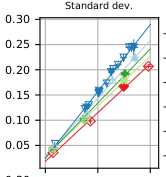 |
Turbulence simulations play a key role in advancing the general understanding of the physical properties turbulence and in interpreting astrophysical observations of turbulent plasmas. For the sake of simplicity, however, turbulence simulations are often conducted in the isothermal limit. Given that the majority of astrophysical systems are not governed by isothermal dynamics, we aim to quantify the impact of thermodynamics on the physics of turbulence, through varying adiabatic index, γ, combined with a range of optically thin cooling functions. In this paper, we present a suite of ideal magnetohydrodynamics simulations of thermally balanced stationary turbulence in the subsonic, super-Alfvénic, high beta (ratio of thermal to magnetic pressure) regime, where turbulent dissipation is balanced by two idealized cooling functions (approximating linear cooling and free-free emission) and examine the impact of the equation of state by considering cases that correspond to isothermal, monatomic and diatomic gases. We find a strong anticorrelation between thermal and magnetic pressure independent of thermodynamics, whereas the strong anticorrelation between density and magnetic field found in the isothermal case weakens with increasing γ. Similarly, with the linear relation between variations in density and thermal pressure with sonic Mach number becomes steeper with increasing γ. This suggests that there exists a degeneracy in these relations with respect to thermodynamics and Mach number in this regime, which is dominated by slow magnetosonic modes. These results have implications for attempts to infer (e.g.) Mach numbers from (e.g.) Faraday rotation measurements, without additional information regarding the thermodynamics of the plasma. However, our results suggest that this degeneracy can be broken by utilizing higher-order moments of observable distribution functions. |
| P. Grete, B. W. O'Shea, and K. Beckwith | |
| 2020 The Astrophysical Journal 889 19 doi:10.3847/1538-4357/ab5aec arXiv:1908.03989 |
| ENZO: An Adaptive Mesh Refinement Code for Astrophysics (Version 2.6) | |
|---|---|
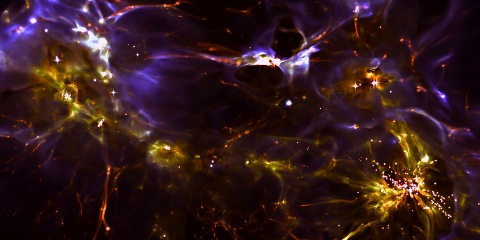 Image credit: John Wise Image credit: John Wise |
Enzo is a block-structured adaptive mesh refinement code that is widely used to simulate astrophysical fluid flows (primarily, but not exclusively, cosmological structure formation, star formation, and turbulence). The code is a community project with dozens of users, and has contributed to hundreds of peer-reviewed publications in astrophysics, physics, and computer science. The code utilizes a Cartesian mesh can be run in one, two, or three dimensions. It supports a wide variety of physics including (magneto)hydrodynamics, the self-gravity of fluids and particles, cosmological expansion, primordial gas chemistry, optically thin radiative plasma cooling, radiation transport, conduction, and models for star formation, stellar feedback, and the feedback from supermassive black holes. |
| The Enzo collaboration (Brummel-Smith et al. incl. P. Grete) | |
| 2019 Journal of Open Source Software 4(42), 1636 10.21105/joss.01636 |
| Kinetic and internal energy transfer in implicit large-eddy simulations of forced compressible turbulence | |
|---|---|
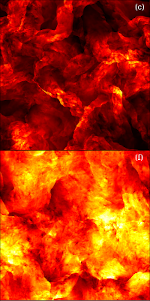 |
We revisit the problem of how energy transfer through the turbulent cascade operates in compressible hydrodynamic turbulence. In general, there is no conservative compressible cascade since the kinetic and internal energy reservoirs can exchange energy through pressure dilatation. Moreover, statistically stationary turbulence at high Mach number can only be maintained in nearly isothermal gas, i.e. if excess heat produced by shock compression and kinetic energy dissipation is continuously removed from the system. We mimic this process by a linear cooling term in numerical simulations of turbulence driven by stochastic forcing. This allows us to investigate turbulence statistics for a broad range of Mach numbers. We compute the rate of change of kinetic and internal energy in wavenumber shells caused by advective, compressive, and pressure dilatation effects and constrain power-law fits to compressible turbulence energy spectra to a range of wavenumbers in which the total energy transfer is close to zero. The resulting scaling exponents are significantly affected by the forcing. Depending on the root mean square Mach number, we find a nearly constant advective component of the cross-scale flux of kinetic energy at intermediate wavenumbers for particular mixtures of solenoidal and compressive modes in the forcing. This suggests the existence of a natural, Mach number dependent mixture of forcing modes. Our findings also support an advection-dominated regime at high Mach numbers with specific scaling exponents (Burgers scaling for the pure velocity fluctuation u and Kolmogorov scaling for the mass-weighted variable \(v=ρ^{1/3} u\) ) |
| W. Schmidt and P. Grete | |
| 2019 Phys. Rev. E 100, 043116 doi:10.1103/PhysRevE.100.043116 arXiv:1906.12228 |
| Intermittent fragmentation and statistical variations during gas collapse in magnetized atomic cooling haloes | |
|---|---|
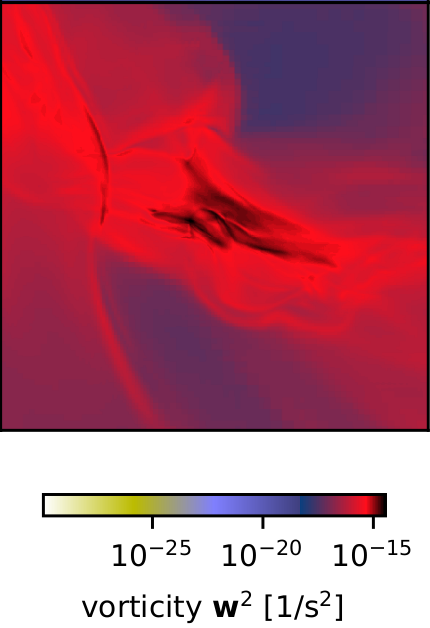 |
Observations reveal the presence of supermassive black holes (SMBH) as early as ~700 million years after the Big Bang. Their formation path is still subject to current debate. We explore the influence of magnetic fields, which are strongly amplified via the turbulent small-scale dynamo, on the formation of SMBH seeds within the direct collapse scenario. In this study, we perform for the first time cosmological magnetohydrodynamic large eddy simulations that employ a model for unresolved, compressible MHD turbulence. In total we perform 36 simulations for 9 haloes each with two different initial magnetic field strengths, and with and without employing the unresolved turbulence model. We make use of the adaptive mesh refinement approach to achieve an effective spatial resolution of less than one proper astronomical unit. We consider a regime where cooling is regulated by atomic hydrogen and the molecular hydrogen gets dissociated by a strong radiation field. Our main finding is that the majority of the gas properties in the haloes at the final output are predominantly determined by the run-away gravitational collapse. Turbulence is supersonic and super-Alfvénic in all cases, and magnetic fields are amplified to an approximately dynamically relevant regime. Finally, fragmentation during the collapse is intermittent and mass accretion rates range from 0.2-3 Msun/yr. This suggests that the presence of strongly amplified magnetic fields and turbulence provides additional pressure support on small scales and make the direct collapse a viable scenario for the formation of massive objects under the required ambient conditions. |
| P. Grete, M. A. Latif, D. R. G. Schleicher, and W. Schmidt | |
| 2019 Monthly Notices of the Royal Astronomical Society 487 (4), 4525–4535 doi:10.1093/mnras/stz1568 arXiv:1903.00017 |
| Correlations and Cascades in Magnetized Turbulence | |
|---|---|
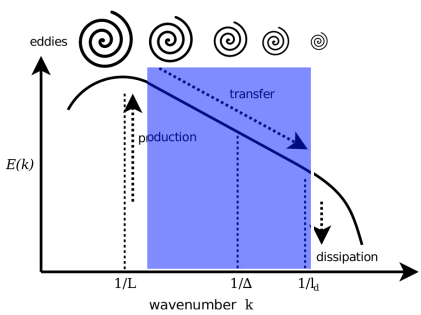 |
Many terrestrial and astrophysical plasmas encompass very large dynamical ranges in space and time, which are not accessible by direct numerical simulations. Thus, idealized subvolumes are often used to study small-scale effects including the dynamics of magnetized turbulence. A significant aspect of magnetized turbulence is the transfer of energy from large to small scales, in part through the operation of a turbulent cascade. In this paper, we present a new shell-to-shell energy transfer analysis framework for understanding energy transfer within magnetized turbulence and in particular, through the cascade. We demonstrate the viability of this framework through application to a series of isothermal subsonic and supersonic simulations of compressible magnetized turbulence and utilize results from this analysis to establish a nonlinear benchmark for compressible magnetized turbulence in the subsonic regime. We further study how the autocorrelation time of the driving and its normalization systematically change properties of compressible magnetized turbulence. For example, we find that δ-in-time forcing with a constant energy injection leads to a steeper slope in kinetic energy spectrum and less efficient small-scale dynamo action. We examine how these results can impact a range of diagnostics relevant for a range of terrestrial and astrophysical applications. |
| K. Beckwith, P. Grete, and B. W. O'Shea | |
| 2019 IEEE Transactions on Plasma Science 47, 5 doi:10.1109/TPS.2019.2891934 and public access trough OSTI |
| As a Matter of Force — Systematic Biases in Idealized Turbulence Simulations | |
|---|---|
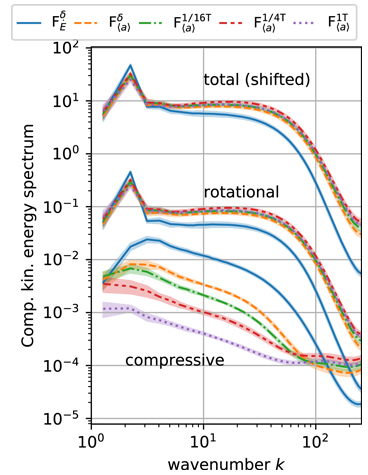 |
Many astrophysical systems encompass very large dynamical ranges in space and time, which are not accessible by direct numerical simulations. Thus, idealized subvolumes are often used to study small-scale effects including the dynamics of turbulence. These turbulent boxes require an artificial driving in order to mimic energy injection from large-scale processes. In this Letter, we show and quantify how the autocorrelation time of the driving and its normalization systematically change properties of an isothermal compressible magnetohydrodynamic flow in the sub- and supersonic regime and affect astrophysical observations such as Faraday rotation. For example, we find that δ-in-time forcing with a constant energy injection leads to a steeper slope in kinetic energy spectrum and less efficient small-scale dynamo action. In general, we show that shorter autocorrelation times require more power in the acceleration field, which results in more power in compressive modes that weaken the anticorrelation between density and magnetic field strength. Thus, derived observables, such as the line-of-sight magnetic field from rotation measures, are systematically biased by the driving mechanism. We argue that δ-in-time forcing is unrealistic and numerically unresolved, and conclude that special care needs to be taken in interpreting observational results based on the use of idealized simulations. |
| P. Grete, B. W. O'Shea, and K. Beckwith | |
| 2018 The Astrophysical Journal Letters 858, L19 doi:10.3847/2041-8213/aac0f5 arXiv:1803.05481 |
| Energy transfer in compressible magnetohydrodynamic turbulence | |
|---|---|
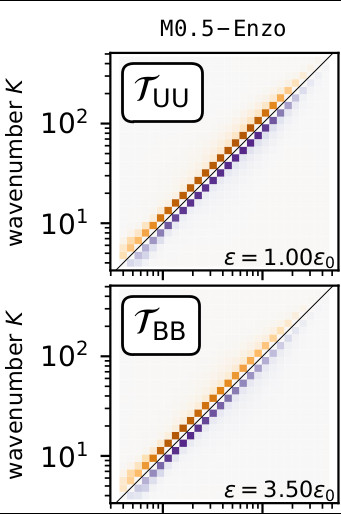 |
Magnetic fields, compressibility and turbulence are important factors in many terrestrial and astrophysical processes. While energy dynamics, i.e. how energy is transferred within and between kinetic and magnetic reservoirs, has been previously studied in the context of incompressible magnetohydrodynamic (MHD) turbulence, we extend shell-to-shell energy transfer analysis to the compressible regime. We derive four new transfer functions specifically capturing compressibility effects in the kinetic and magnetic cascade, and capturing energy exchange via magnetic pressure. To illustrate their viability, we perform and analyze four simulations of driven isothermal MHD turbulence in the sub- and supersonic regime with two different codes. On the one hand, our analysis reveals robust characteristics across regime and numerical method. For example, energy transfer between individual scales is local and forward for both cascades with the magnetic cascade being stronger than the kinetic one. Magnetic tension and magnetic pressure related transfers are less local and weaker than the cascades. We find no evidence for significant nonlocal transfer. On the other hand, we show that certain functions, e.g., the compressive component of the magnetic energy cascade, exhibit a more complex behavior that varies both with regime and numerical method. Having established a basis for the analysis in the compressible regime, the method can now be applied to study a broader parameter space. |
| P. Grete, B. W. O'Shea, K. Beckwith, W. Schmidt and A. Christlieb | |
| 2017 Physics of Plasmas 24, 092311 doi:10.1063/1.4990613 arXiv:1706.06339 | |
| Featured article with accompanying Scilight |
| Comparative statistics of selected subgrid-scale models in large-eddy simulations of decaying, supersonic magnetohydrodynamic turbulence | |
|---|---|
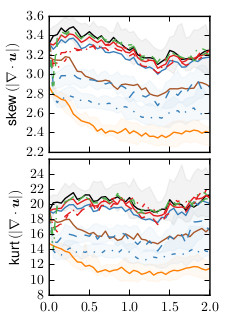 |
Large-eddy simulations (LES) are a powerful tool in understanding processes that are inaccessible by direct simulations due to their complexity, for example, in the highly turbulent regime. However, their accuracy and success depends on a proper subgrid-scale (SGS) model that accounts for the unresolved scales in the simulation. We evaluate the applicability of two traditional SGS models, namely the eddy-viscosity (EV) and the scale-similarity (SS) models, and one recently proposed nonlinear (NL) SGS model in the realm of compressible magnetohydrodynamic (MHD) turbulence. Using 209 simulations of decaying, supersonic (initial sonic Mach number Ms≈3) MHD turbulence with a shock-capturing scheme and varying resolution, SGS model, and filter, we analyze the ensemble statistics of kinetic and magnetic energy spectra and structure functions. Furthermore, we compare the temporal evolution of lower- and higher-order statistical moments of the spatial distributions of kinetic and magnetic energy, vorticity, current density, and dilatation magnitudes. We find no statistical influence on the evolution of the flow by any model if grid-scale quantities are used to calculate SGS contributions. In addition, the SS models, which employ an explicit filter, have no impact in general. On the contrary, both the EV and NL models change the statistics if an explicit filter is used. For example, they slightly increase the dissipation on the smallest scales. We demonstrate that the nonlinear model improves higher-order statistics already with a small explicit filter, i.e., a three-point stencil. The results of, e.g., the structure functions or the skewness and kurtosis of the current density distribution are closer to the ones obtained from simulations at higher resolution. In addition, no additional regularization to stabilize the model is required. We conclude that the nonlinear model with a small explicit filter is suitable for application in more complex scenarios when higher-order statistics are important. |
| P. Grete, D. G. Vlaykov, W. Schmidt and D. R. G. Schleicher | |
| 2017 Phys. Rev. E 95, 033206 doi:10.1103/PhysRevE.95.033206 arXiv:1703.00858 |
| A nonlinear structural subgrid-scale closure for compressible MHD. I. Derivation and energy dissipation properties | |
|---|---|
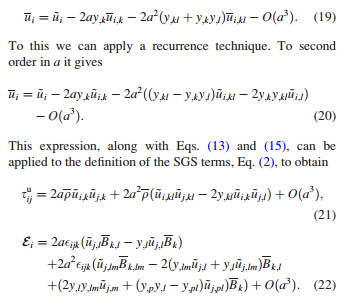 |
Compressible magnetohydrodynamic (MHD) turbulence is ubiquitous in astrophysical phenomena ranging from the intergalactic to the stellar scales. In studying them, numerical simulations are nearly inescapable, due to the large degree of nonlinearity involved. However, the dynamical ranges of these phenomena are much larger than what is computationally accessible. In large eddy simulations (LESs), the resulting limited resolution effects are addressed explicitly by introducing to the equations of motion additional terms associated with the unresolved, subgrid-scale dynamics. This renders the system unclosed. We derive a set of nonlinear structural closures for the ideal MHD LES equations with particular emphasis on the effects of compressibility. The closures are based on a gradient expansion of the finite-resolution operator [W. K. Yeo (CUP, 1993)] and require no assumptions about the nature of the flow or magnetic field. Thus, the scope of their applicability ranges from the sub- to the hyper-sonic and -Alfvénic regimes. The closures support spectral energy cascades both up and down-scale, as well as direct transfer between kinetic and magnetic resolved and unresolved energy budgets. They implicitly take into account the local geometry, and in particular, the anisotropy of the flow. Their properties are a priori validated in Paper II [P. Grete et al., Phys. Plasmas 23, 062317 (2016)] against alternative closures available in the literature with respect to a wide range of simulation data of homogeneous and isotropic turbulence. |
| D. G. Vlaykov, P. Grete, W. Schmidt and D. R. G. Schleicher | |
| 2016 Physics of Plasmas 23, 062317 doi:10.1063/1.4954303 arXiv:1606.02064 |
| A nonlinear structural subgrid-scale closure for compressible MHD. II. A priori comparison on turbulence simulation data | |
|---|---|
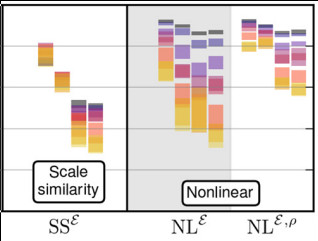 |
Even though compressible plasma turbulence is encountered in many astrophysical phenomena, its effect is often not well understood. Furthermore, direct numerical simulations are typically not able to reach the extreme parameters of these processes. For this reason, large-eddy simulations (LES), which only simulate large and intermediate scales directly, are employed. The smallest, unresolved scales and the interactions between small and large scales are introduced by means of a subgrid-scale (SGS) model. We propose and verify a new set of nonlinear SGS closures for future application as an SGS model in LES of compressible magnetohydrodynamics. We use 15 simulations (without explicit SGS model) of forced, isotropic, homogeneous turbulence with varying sonic Mach number Ms=0.2–20 as reference data for the most extensive a priori tests performed so far in literature. In these tests, we explicitly filter the reference data and compare the performance of the new closures against the most widely tested closures. These include eddy-viscosity and scale-similarity type closures with different normalizations. Performance indicators are correlations with the turbulent energy and cross-helicity flux, the average SGS dissipation, the topological structure and the ability to reproduce the correct magnitude and the direction of the SGS vectors. We find that only the new nonlinear closures exhibit consistently high correlations (median value > 0.8) with the data over the entire parameter space and outperform the other closures in all tests. Moreover, we show that these results are independent of resolution and chosen filter scale. Additionally, the new closures are effectively coefficient-free with a deviation of less than 20%.
|
| P. Grete, D. G. Vlaykov, W. Schmidt and D. R. G. Schleicher | |
| 2016 Physics of Plasmas 23, 062317 doi:10.1063/1.4954304 arXiv:1606.01573 |
| Nonlinear closures for scale separation in supersonic magnetohydrodynamic turbulence | |
|---|---|
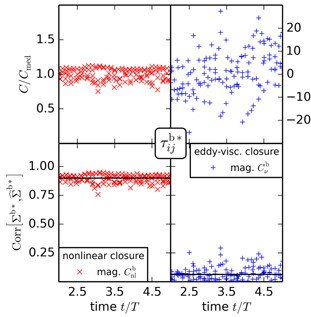 |
Turbulence in compressible plasma plays a key role in many areas of
astrophysics and engineering. The extreme plasma parameters in these
environments, e.g. high Reynolds numbers, supersonic and
super-Alfvenic flows, however, make direct numerical simulations
computationally intractable even for the simplest
treatment — magnetohydrodynamics (MHD).
To overcome this problem one can use subgrid-scale (SGS) closures—models
for the influence of unresolved, subgrid-scales on the resolved ones.
In this work we propose and validate a set of constant coefficient
closures for the resolved, compressible, ideal MHD equations.
The SGS energies are modeled by Smagorinsky-like equilibrium closures.
The turbulent stresses and the electromotive force (EMF) are described
by expressions that are nonlinear in terms of large scale velocity and
magnetic field gradients. To verify the closures we conduct a priori
tests over 137 simulation snapshots from two different codes with varying
ratios of thermal to magnetic pressure (\(\beta_{\rm p}=0.25,1,2.5,5,25\))
and sonic Mach numbers ( \( M_{\rm s}=2,2.5,4 \) ). Furthermore, we make a comparison to
traditional, phenomenological eddy-viscosity and \( \alpha -\beta -\gamma \) closures.
We find only mediocre performance of the kinetic eddy-viscosity
and \(\alpha -\beta -\gamma \) closures, and that the magnetic eddy-viscosity closure is poorly correlated with the simulation data. Moreover, three of five coefficients of the traditional closures exhibit a significant spread in values. In contrast, our new closures demonstrate consistently high correlations and constant coefficient values over time and over the wide range of parameters tested. Important aspects in compressible MHD turbulence such as the bi-directional energy cascade, turbulent magnetic pressure and proper alignment of the EMF are well described by our new closures.
|
| P. Grete, D. G. Vlaykov, W. Schmidt, D. R. G. Schleicher and C. Federrath | |
| 2015 New J. Phys. 17, 023070 doi:10.1088/1367-2630/17/2/023070 arXiv:1501.07170 |